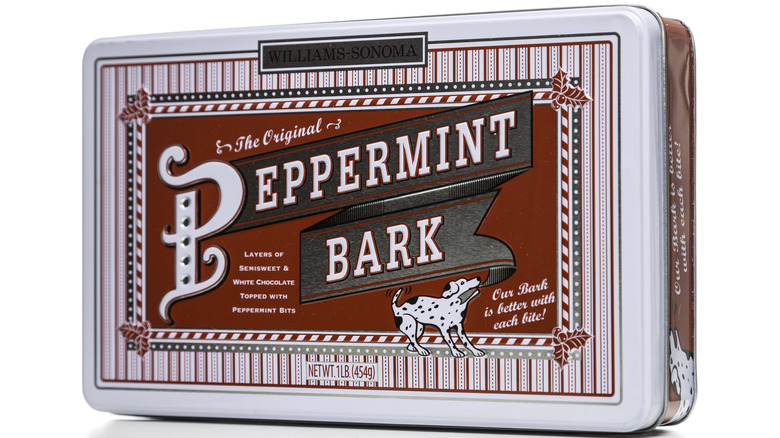The Mystery Behind Who Invented Peppermint Bark
What does Christmas taste like? Some might say ginger, others apples and cinnamon, but it's hard not to land on that favorite winter combo of peppermint and chocolate. The two have been married in many forms, but none plays as ubiquitous a role in the holiday season as peppermint bark. Superficially, it's simple as can be. Peppermint bark uses just three ingredients: a dark chocolate base topped with a layer of white chocolate and crushed peppermint candy. But when you bring the three together, every bite evokes the holiday spirit.
Peppermint bark feels like a very nostalgic food. Its simplicity harkens back to a bygone age when candy was made in small batches by local mom-and-pop shops ... at least, that's what it feels like. In reality, peppermint bark has been a holiday staple for barely two decades. In the United States, it wasn't widely popularized until the late 1990s, when the kitchen supply chain WIlliams Sonoma made it a seasonal specialty.
Peppermint bark wasn't a new invention at that point, but its actual origins are too hazy to pin down. We know that it existed at least as early as 1966, when an advertisement appeared in the St. Petersburg Times offering peppermint bark by the pound for just $1.19. Curiously enough, this ad ran in mid-September, months ahead of our currently accepted peppermint bark season. Nobody knows who invented this treat, but if we scour the globe for comparisons, a possible predecessor comes to light.
Peppermint bark may descend from a French dessert
Peppermint bark is a type of sheet candy, which is to say it is made in large, thin sheets that are then broken up into bite-sized portions. It's assumed that the name "peppermint bark" comes from the craggy slabs' resemblance to tree bark, which can be similarly chipped away. Another example of a popular American sheet candy would be peanut brittle, but if we venture overseas to France, we find a type of sheet candy whose appearance and seasonality is much more akin to our beloved peppermint bark: mendiants.
Mendiants are made from tempered chocolate studded with crushed-up morsels of nuts and dried fruit. The method used to make them is quite similar to that of peppermint bark, although mendiants are only sometimes formed in sheets.
Mendiants originally were meant to have four toppings — almonds, raisins, hazelnuts, and figs — related to the four monastic orders of the Catholic Church. However, today the French treat can be sprinkled with just about every kind of nut and candied fruit you can imagine. Peppermint bark is essentially a mendiant made with crushed peppermint candy in the place of traditional French toppings.
How peppermint bark became a holiday staple
We will probably never know which individual, if any, we can credit with inventing peppermint bark, but we certainly know who deserves credit for making it a Christmas classic. That was the work of one Chuck Williams, the founder and namesake of Williams-Sonoma (the latter half of the company's name honors Sonoma, California, where Williams opened his first store). In 1998, Williams assembled a small team of employees and tasked them with creating a nostalgic treat to sell for the holidays. Williams wanted something that would harken back to the candy shops of his youth; peppermint bark, with its rough, homemade aesthetic, was the perfect thing.
Williams and co tried 20 different recipes before finally landing on the perfect blend of chocolate and peppermint. They teamed up with chocolatier Guittard and developed signature blends of dark and white chocolate exclusive to Williams Sonoma. They also put a twist on the simple recipe by adding peppermint oil to the chocolate itself.
Williams-Sonoma's foray into peppermint bark proved to be a massive hit with customers, and today, the company has spun its winning formula off into almost 20 different peppermint bark products, including brownies, candy apples, and coffee capsules. Williams-Sonoma only produces peppermint bark for 12 weeks a year, firmly establishing the winter holidays as peppermint bark season. Since their initial success, other chocolate companies, most notably Ghirardelli, have followed suit, and today, we associate Christmas with a massive influx of peppermint bark to our grocery shelves.


